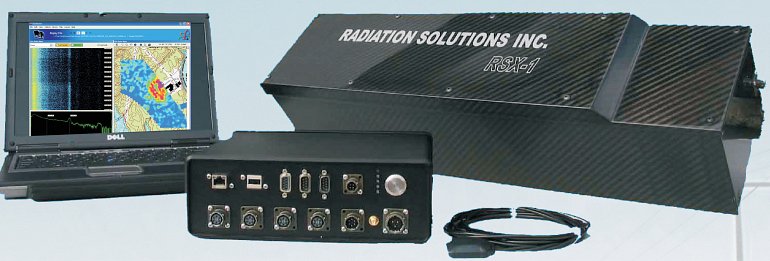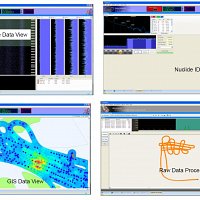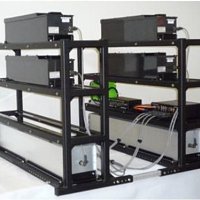RS700
from Radiation Solutions
The RS-700 is a self-contained gamma-ray and neutron (optional) radiation detection and monitoring system. It can be used in land vehicles, helicopters, UAVs or at a fixed location.
The system is flexible enough to permit real-time monitoring with a computer or operate in a stand alone configuration with the data being recorded internally and later retrieved. Alternatively, the data can be transmitted to a remote monitoring location. The RS-700 utilizes advanced DSP / FPGA* technology and software techniques that provide laboratory levels of spectral performance that were previously unachievable on mobile platforms. Despite it’s state-of-the-art technology, the RS-700 is extremely operator friendly and can be rapidly deployed. The system is also capable of unattended operation if required.

The spectrometer operates up to 250,000 cps without any spectral distortion and with less than 20% dead time at that count rate. Generally with usual background conditions, the dead time is essentially zero. The resolution can be selected as 512 or 1024 channels and the typical measuring range is 20keV – 3MeV.
This 1024 channel spectrum is unique in the industry as it s fully linearized, without changing the Poisson distribution performance. The exceptional advantage of this new proprietary process is that any number of individual detectors can be summed together with essentially no spectral degradation for subsequent data analysis.
The RS-700 can also be configured with a single or dual model RSX-1 NaI gamma detector and a 3He tube array for neutron detection packaged in a vehicle roof-top carrier.
The system has a built-in GPS receiver to accurately locate each measurement. It is also supplied with the RadAssist survey software program for user control, monitoring and recording.
RadAssist Features;
- Set up of Operating and Device Parameters
- System control
- Monitor the data, spectral, strip chart format, map view with breadcrumb trail etc.
- Perform Nuclide Identification
- The Recording and Exporting of data
- Event Log
- Various ‘toolbox’ utilities to ensure system performance
Product Dimensions
| Physical | Dimensions (L x W x H) | Weight |
|---|---|---|
| RS700 (instrument only) | 73cm x 16cm x 17cm (rsx-1) | 22.7kg |
Technical Specifications
| Channels: | 1024 |
|---|---|
| Differential nonlinearity: | <0.2% over top 99.5%. |
| Integral nonlinearity: | <0.01% over top 99.5%. |
| Dead Time: | A live time clock adjusts for measured pile-up rejections to give an apparent dead time to ensure the absolute count rate is correct. |
| Pile-up rejection: | Digital (<40nS). |
| Pile-up contamination: | <1% @ 250kcps. |
| Sample rate: | 0.1-10 per second. |
| Gain stabilization: | Automatic multi-peak. |
| Comunication: | Ethernet. RS-232 19200115200 bit/s. USB memory stick. |
| Detectors: | RSX-1 4L NaI (TI) detector or RSX-3x3 0.4L NaI(TI) |
| Power: | Sonsors: 9-40 VDC, 6 W. Console: 15W |
| Operating Temperature: | -30 C to +45 C. |


